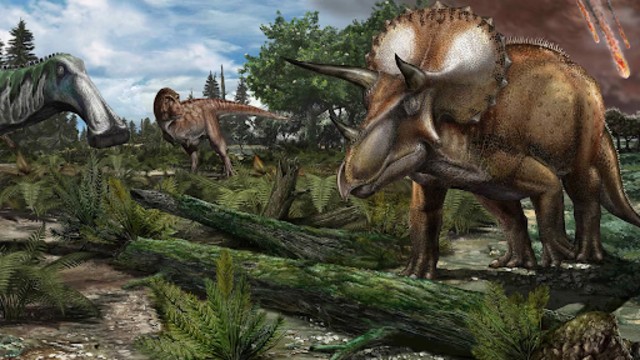
This image is an artist’s interpretation of how North America might have appeared 66 million years ago. (CNN Newsource)
Were dinosaurs already struggling before the massive asteroid hit Earth 66 million years ago? Or did they vanish because of that one sudden event? A group of scientists studied fossils from North America to try and find out. They focused on the 18 million years before dinosaurs went extinct.
At first glance, the fossils show that dinosaur species peaked around 75 million years ago. Then, their numbers dropped in the last 9 million years before the asteroid. But scientists now say this may not tell the full story.
Chris Dean, a paleontologist and lead researcher, explained that the fossil record is not perfect. It gives a limited view of what life looked like millions of years ago. Some places had more rocks exposed than others, which affects where fossils are found.
To get clearer results, the team used a method called occupancy modeling. This method helps find out where animals likely lived, even if no fossils were discovered there. It’s a tool often used in modern conservation work, but this was the first time it helped study dinosaurs.
Dean and his team looked at four big dinosaur groups. These were:
- Ankylosaurs (armored plant-eaters)
- Ceratopsians (like the three-horned Triceratops)
- Hadrosaurs (duck-billed dinosaurs)
- Tyrannosaurs (meat-eaters like T. rex)
They used maps to divide North America into grid sections. Then they looked at where fossils had been found and how often those places were searched. Their model showed that the areas these dinosaurs lived in didn’t really shrink over time. This means their numbers likely didn’t drop as much as earlier fossil records suggested.
One big issue was the amount of rock exposed on the surface. Not much rock from the final years of the dinosaurs’ time on Earth is easy to reach today. So, fossil hunters find fewer remains from that period—not because there were fewer dinosaurs, but because there’s less rock to search.
Alfio Alessandro Chiarenza, a co-author of the study, said these missing fossils may be due to natural changes like mountain building and falling sea levels. He believes dinosaurs were not bound to go extinct and may have lived much longer if the asteroid had never hit.
Other experts also shared their views. Darla Zelenitsky, who didn’t work on the study, agreed that rocks play a big role in how we view dinosaur history. More surface rock leads to more fossil finds, which gives a better idea of how many dinosaurs lived during a certain time.
Still, not everyone is fully convinced. Mike Benton, a scientist from the UK, praised the research but said it doesn’t prove dinosaurs weren’t already in decline. He thinks more work is needed to confirm this idea.
This new research offers a fresh look at a long-debated topic. It shows that how and where we find fossils can greatly shape what we believe about life long ago.















